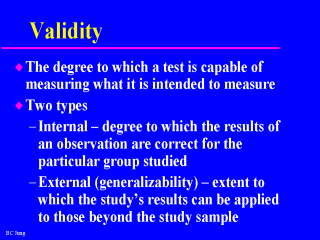 |
Internal Validity – If a study is to be useful, it must
be internally valid. But even if is internally valid, the results sometimes cannot be
compared with other studies. Systematic error is what threatens internal validity the
most. Good design and attention to detail is important to ensure internal validity. External
Validity - Internal validity is necessary for external validity, and easier to achieve.
External validity needs external quality control of the measurements and judgments about
the degree to which the results can be extrapolated. This does not require the sample to
be representative of a reference population. Good study design and clearly-stated
hypotheses and a well-defined population contribute to external validity. |
